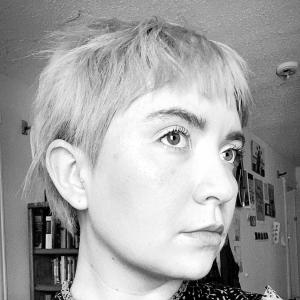Work by Christine McDonald

- Christine McDonald, M.F.A. in Creative Visual Arts 2022
Hometown
Philadelphia, PennsylvaniaWebsite
Christine McDonald
Steel Wool Overcoat (2021)
These artworks are road works — experiments with infrastructures. I approach the versatility of a metaphoric steel overcoat as a mode of transportation, the punctuation of landscape, and a material that transforms a people in asphaltic streams. Coats of wool, coats of kin, coats that dance and wiggle and drive; heaving through racetracks with uncertain effort. The pathways of animals intersect in an intrinsic way around my studio and layers of earth and layers of bodies are interpreted and reimagined through the transitional properties of processed iron as they cast off from die-cut woolen form into powder. These entropic, weightless rocks mixed with a bit of precipitation become a myriad of evidence-oxidized inks.
It was a dreamy accident that I became enamored with waulking steel wool into peltish cloaks and covering things; waulking referring to the song-filled Gaelic tradition of purifying and shrinking sheep's wool into cloth. The method I use involves less purification and direct animal matter and rather relies on brush-stitching steel wool pads together while massaging them with a saltwater acid to transform the iron into the transitional state of iron oxide, reddish, orangey, yellowy, and sometimes black rust. These offshoots of the sculptures become varying pigments for drawing and interpreting layers of air and earth. The soft-looking pelt sculptures titled Steel Wool Overcoat and Oversized Steel Wool Overcoat are in a constant state of disintegration and hardening; what exists on the "safety yellow" synoptic table of this work are the "rocks" and dust particle sticky-states of the materials after months of air baths in saltwater. Interestingly, rust/iron oxide is not the complete destruction of iron; if one were to launch a concentrated amount of hydrogen at a pile of rust, one would once again make iron.
The public and social contract of holding onto, donning costumes, and using pathways for transportation is the catalyst and driving force behind my current research and studio practice. Embracing the mysterious rituals of transportation, both for the living and the dead, involves the use of color as punctuating language, explorations of ranges between the support structures and material motifs, connective tissues in their softest and hardest forms, noticing the racetracks of daily life or doing repetitively the same driving commute, and the reversal of specific gravities as necessary to convey the weight and light of each iteration.



